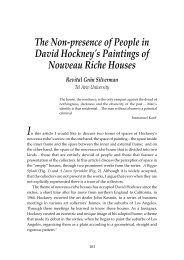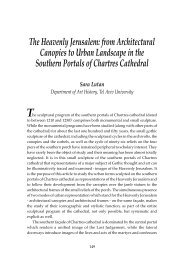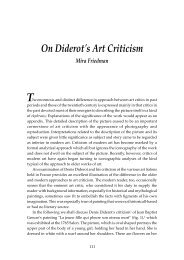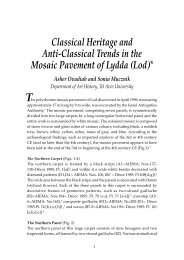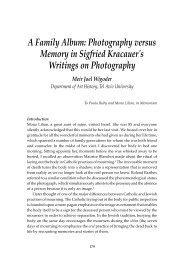The Temple in the Iconography of Early Christian Art Carla Gomez ...
The Temple in the Iconography of Early Christian Art Carla Gomez ...
The Temple in the Iconography of Early Christian Art Carla Gomez ...
You also want an ePaper? Increase the reach of your titles
YUMPU automatically turns print PDFs into web optimized ePapers that Google loves.
Fig. 6: Northumbria, Franks Casket, whalebone chest.<br />
differences <strong>in</strong> <strong>the</strong> background featur<strong>in</strong>g <strong>the</strong> <strong>Temple</strong>. On <strong>the</strong> chair panel Leclercq<br />
identifies <strong>in</strong> <strong>the</strong> background <strong>the</strong> <strong>Temple</strong> colonnade. 48 Beh<strong>in</strong>d <strong>the</strong> figure on <strong>the</strong><br />
left, identified as Joseph, <strong>the</strong>re are two spiral columns with capitals, perhaps<br />
Cor<strong>in</strong>thian, that support a diagonally-shaped cornice and beh<strong>in</strong>d all <strong>of</strong> this - a<br />
brick wall.<br />
On <strong>the</strong> Etchimiadz<strong>in</strong> book cover below a scene <strong>of</strong> <strong>the</strong> Annunciation, is a<br />
representation <strong>of</strong> <strong>the</strong> Ordeal <strong>of</strong> <strong>the</strong> Bitter Water. With great difficulty one can<br />
make out on <strong>the</strong> left <strong>of</strong> <strong>the</strong> scene a spiral column and <strong>the</strong> beg<strong>in</strong>n<strong>in</strong>g <strong>of</strong> an arch.<br />
On ano<strong>the</strong>r sixth century ivory, preserved <strong>in</strong> Moscow <strong>the</strong> arch symboliz<strong>in</strong>g<br />
<strong>the</strong> <strong>Temple</strong> is complete and rest<strong>in</strong>g on two spiral pillars. 49 In all <strong>the</strong>se sixth<br />
century works, <strong>the</strong> configuration <strong>of</strong> <strong>the</strong> scene and <strong>the</strong> betoken<strong>in</strong>g <strong>of</strong> <strong>the</strong> <strong>Temple</strong><br />
by arch and pillars is basically <strong>the</strong> same, with discrepancies <strong>of</strong> detail only.<br />
However, <strong>the</strong> same architectural elements occur <strong>in</strong> o<strong>the</strong>r scenes that are quite<br />
unconnected to <strong>the</strong> <strong>Temple</strong> or even to Jerusalem.<br />
<strong>The</strong> ivory Werden Casket or Pyxis was made <strong>in</strong> Italy between 425-450 and<br />
illustrates various New Testament scenes from <strong>the</strong> Annunciation to <strong>the</strong> Visit <strong>of</strong><br />
<strong>the</strong> Magi. Some scholars identify <strong>the</strong> scene after <strong>the</strong> Annunciation as <strong>the</strong> Ordeal<br />
<strong>of</strong> <strong>the</strong> Bitter Water, partly because that is <strong>the</strong> scene which, <strong>in</strong> <strong>the</strong> accepted<br />
chronological sequence, follows <strong>the</strong> Annunciation. 50 Contrast<strong>in</strong>g op<strong>in</strong>ion is that<br />
<strong>the</strong> scene shows <strong>the</strong> Presentation <strong>of</strong> Mary <strong>in</strong> <strong>the</strong> <strong>Temple</strong>, as found on <strong>the</strong> Milan<br />
ivory book cover. 51 Whatever <strong>the</strong> case, <strong>the</strong> build<strong>in</strong>g <strong>in</strong> <strong>the</strong> scene must be <strong>the</strong><br />
<strong>Temple</strong>. It is represented as a massive structure, stand<strong>in</strong>g on a high podium<br />
(half <strong>the</strong> height <strong>of</strong> <strong>the</strong> <strong>Temple</strong> itself) constructed <strong>of</strong> blocks <strong>of</strong> dressed stone<br />
72



